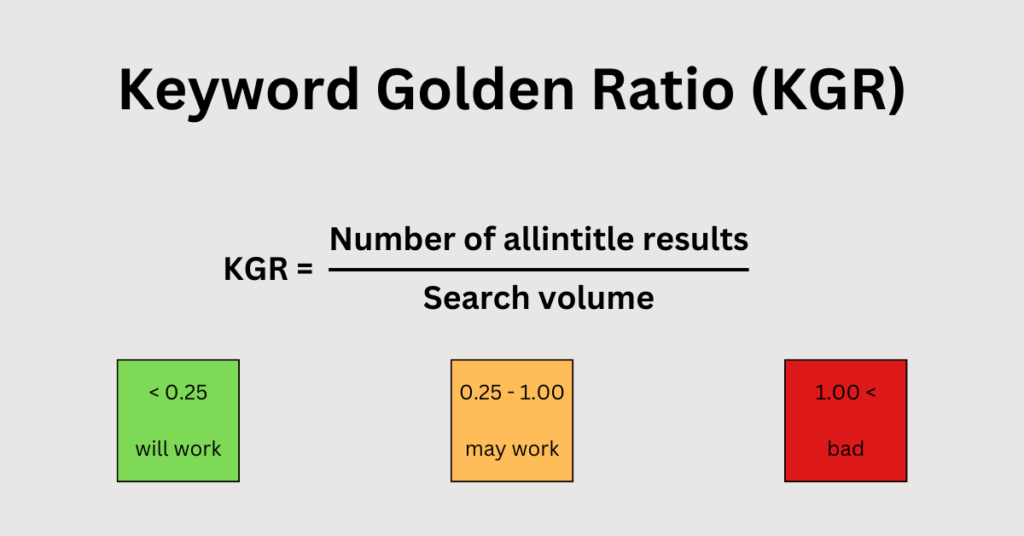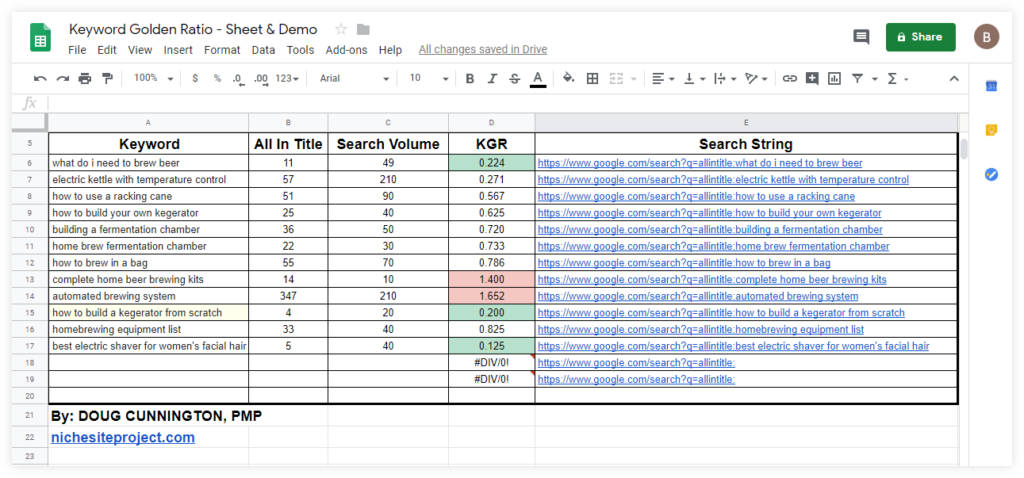Introduction: What is keyword golden ratio (KGR) technique
Finding powerful keywords is essential to succeeding in search engine optimization (SEO). Although obtaining high-volume, low-competition gems might appear unattainable in the face of dominant competitors, the Keyword Golden Ratio (KGR) provides a tactical advantage.
By revealing the nuances of KGR techniques, ideal selection, advantages, and disadvantages- this blog gives you the tools to transform your approach to keyword research. Improve your approach and capture organic traffic with unprecedented accuracy. Once you’ve read this article, you should easily incorporate the KGR method into your SEO strategy.
The Keyword Golden Ratio (KGR), developed by Niche Site Project’s Doug Cunnington, reveals a systematic approach to identifying underutilized, low-competition target keywords. These frequently appear as overlooked long-tail gems that rivals overlook because of their low monthly search volume.
The genius of KGR is how narrowly it focuses on these seemingly specialized terms. The secret to the method’s success is gathering a horde of superior content generated by multiple KGR keywords. When properly optimized, these keywords surpass the competition in high-volume searches and provide a shortcut to Google’s zenith.
KGR-specific pages can move up the ranks in just a few days after they are published with an established website. Gain unparalleled visibility for your content by perfecting the KGR technique.
How to calculate the keyword golden ratio?
To use the keyword golden ratio (KGR) you’ll need to need two important pieces of information. The number of “allintitle” keyword results and their search volume. KGR= No. of allintitle results/ Search volume
How can you obtain these figures? Let’s begin by discussing the “allintitle” results. An advanced Google search operator called Allintitle can be used to locate pages that have the exact search term contained in their title.
For instance, if your long-tail keyword is “keywords for seo,” you can use the Google search bar to find the “allintitle” results as follows:
allintitle:keywords for seo

According to the search query mentioned above, “keywords for seo” appear in the page titles of 25,300 pages. Finding the keyword’s search volume is the next step. You can use any tool for this eg: SEMRush, Ahrefs, or Keywordtool.io.

The search volume for the keyword “keywords for seo” is 2,400
It’s crucial to remember that for the KGR method to function as effectively as possible, you must search keywords up to 250 times per month. This is because low search volume keywords are simpler to rank for than ones with thousands of monthly searches.
Although the 250 search volume cap might seem excessively low, it’s a good guideline to abide by, particularly when launching a new website. You can rank your website highly on Google SERPs by optimizing it for multiple KGR keywords. After your content has generated enough traffic, you can target KGR keywords with higher monthly search volumes.
Now that you have all the information required to determine the KGR score, let’s do so using this formula:

The KGR score based on our example is 25,300/2400 = 10.54.
What’s the meaning of the score?
The probability of the keyword ranking highly on SERPs is indicated by the KGR score. As a result, the likelihood that your content will rank quickly for the selected keyword increases with a lower score.
Whenever the KGR rating is:
- Less than 0.25: higher likelihood of being placed highly
- In the range of 0.25 to 1.00: somewhat likely to be ranked highly
- Greater than 1.00: less likelihood of being placed highly
Getting a KGR score of 0.25 or less is the goal. Although keywords with KGR scores between 0.251 and 1.0 are acceptable, you should give lower KGR scores more weight.
So it’s not advised to write content with “keywords for seo” as the primary keyword because our example’s KGR score of 10.54 is significantly higher than the ideal 0.25.
Now that this keyword is not appropriate you need to spend some time more to research potential fit.

Tips for ranking KGR keywords
Now that you have a basic understanding of what is keyword golden ratio it’s time to look at some tips that are important for the technique to work.
1. Allocate numerous articles that are KGR keyword-optimized
Throughout the conversation, there are echoes of people saying that KGR is useless. Some tried to adopt it, writing articles specifically for KGR keywords, but they didn’t show up in the desired rankings.
However, understanding KGR requires moving away from ephemeral expectations. It’s a long-term project that requires a carefully thought-out content strategy. To fully utilize KGR, you must set out on a journey where preparation goes beyond a single article. Publishing and gradually revealing a tapestry of KGR-infused content over three months or longer is crucial.
Google learns to dance to the beat of your website during this rhythmic creation process. Consistently producing new and original content complements the KGR approach, helping you climb Google’s ranks and promoting topic relevance.
Gradually, the KGR symphony emerges, with every note signifying a calculated move towards long-term prosperity.
2. Build backlinks for your page
Within the larger scheme of SEO tactics, KGR is a significant piece that can improve the organic traffic to your website. But depending just on KGR might not get you where you want to go if you don’t combine it with other things that work well together.
Although building backlinks is sometimes seen as the most difficult aspect of SEO, it is a crucial component that has a significant impact on your website. This is especially true in highly competitive niches where content might not be enough. Building a strong base via the development of high-quality backlinks is just as important as KGR to boost your ranking on SERPs. Unleash these components’ combined power to pave the way for SEO success.
3. Look for keyword intent
When exploring the KGR keyword optimization space, don’t forget to explore the complex web of search intent. Discover the motivation behind user inquiries to create content that aptly responds to them.
Examine a variety of search intent categories, including transactional, commercial, informative, and navigational. How-to articles can shed light on the informational landscape, and reviews, pros and cons blogs, and listicles can provide comfort to commercial inquiries. Regarding transactional and navigational quests, direct users to other domains after providing relevant information about the desired good or service. Once you have mastered this subtle dance of search intent, you can be sure that your KGR optimization aligns with user needs.
Advantages of Keyword Golden Ratio
1. Ideal for inexperienced website owners
Building a successful website that draws in organic traffic is no easy task. For inexperienced enthusiasts, the maze of on-page/off-page SEO nuances and the painstaking dance of technical SEO lie beyond the exquisite fabric of flawless content creation.
A guide for beginners navigating the turbulent waters of website development, KGR offers allure. Here, the beauty is revealed as the new website administrators discover the game-changing potential of concentrating on KGR-centric content creation. It’s a methodical ascent, a dance. As the waves of visitors and money wash up on the coast, the journey sets out to conquer increasingly difficult terms and reveal the many facets of the larger picture of web development.
2. Comparatively quick outcomes
KGR is intended to assist website owners in rapidly generating organic traffic. You can boost your search visibility and fill in the content gaps on the SERPs by focusing on low-competition keywords on Google.
Disadvantages of Keyword Golden Ratio
1. Not suitable for content with extremely esoteric themes
The search volume component is a key component in the KGR calculation alchemy. The population actively searching for particular keywords is the KGR method’s dancing partner.
But there’s a catch: the keyword loses appeal as search volume declines and becomes obscure. Creating content based on such flimsy keywords is pointless. The sweet spot is in the middle ground of somewhat competitive keywords, with 250 searches per month. This is where the magic happens—keywords that are somewhat well-known but are hidden by the fact that they are rarely looked up or discovered on the huge internet.
2. It necessitates producing a lot of content
The sheer number of KGR-optimized articles paves the way to website authority in the world of KGR keywords, where search volume whispers. It’s not just a walk in the park; it requires well-planned preparation, a commitment of writing hours, and possibly a financial disaster if hiring independent writers is necessary for the journey. A prodigious symphony of KGR-infused content is necessary for the alchemy of authority, demonstrating the complex dance between strategy, commitment, and resources.
Conclusion
The Keyword Golden Ratio can assist you if you’re trying to drive organic traffic to your website more quickly than with traditional SEO tactics.
Nevertheless, the KGR method’s time-consuming preparation is a drawback. The potential KGR keywords, their search volume, and their “allintitle” results must be located before you can compute the KGR scores.
Remember that just because now you know what is keyword golden ratio it isn’t a secret technique that elevates your website to the top of search results right away. To see its effectiveness, you must conduct research, write, publish, and distribute high-quality content regularly, and supplement it with other SEO strategies.
Ready to take your digital marketing to new heights? From content optimization to strategic keyword targeting, tailor solutions for your success. Contact today and let’s elevate your online presence together.


purchase valacyclovir generic – order generic fluconazole 200mg purchase diflucan online
Your comment is awaiting moderation.